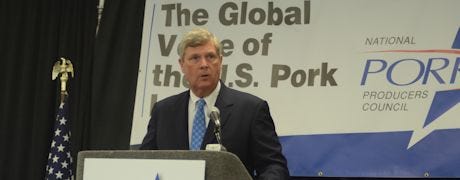
A little over a year after PEDV first appeared in the U.S., Secretary of Agriculture Tom Vilsack made an appearance at the 2014 World Pork Expo to announce funding and discuss a Federal Order to combat porcine epidemic diarrhea virus and porcine deltacoronavirus.
Since the first reported case of PEDV in the U.S. in April 2013, it has spread to 30 states with over 7,000 positive ascensions as of June 4, according to the National Animal Health Laboratory Network.

FEDERAL HELP: Secretary of Agriculture Tom Vilsack announces $26.2 million in funding to help combat PEDV at the World Pork Expo, June 6, 2014, in Des Moines, Iowa.
A year ago, there were just over 100 operations infected with PEDV. "In the last year, that number of nearly 100 has grown to nearly 4,700 operations," Vilsack says. "We're looking at increases of between 150 and 200 operations a week. This is obviously an expanding issue, and one we have to come to grips with. We have to deal with it and deal with it aggressively."
In the last year, PEDV has killed an estimated 7 million piglets. "Producers can't afford to see millions of pigs die, as they have in the past several months. It is estimated we have lost roughly 10% of the herd already," he says. "This not only impacts and affects producer income. It affects access to product which limits export opportunities and the availability of pork to consumers."
However, as Vilsack notes, these viruses aren't a human health concern. "It doesn't translate into something that is of concern to consumers, except for the price and availability of the product," he says. "It's very important for consumers to understand we are talking about viruses that impact the health of animals, not people."
Management and monitoring
The Animal and Plant Health Inspection Service Federal Order requires producers, veterinarians, and diagnostic laboratories to report all cases of PEDV and other new swine enteric coronavirus diseases to USDA and State animal health officials.
The Order also requires operations reporting these viruses to work with their veterinarian or USDA or State animal health officials to develop and implement a reasonable management plan to address the detected virus and prevent it from spreading.
"This does not involve a restriction of movement. This does not involve a quarantine," Vilsack emphasizes. "It does involve reporting and a monitoring plan and management plan."
~~~PAGE_BREAK_HERE~~~
Accompanying this order, USDA announced $26.2 million in funding, available immediately, to these viruses. This includes:
• $3.9 million to be used by USDA's Agricultural Research Service to support the development of vaccines.
• $2.4 million to cooperative agreement funding for states to support management and control activities.
• $500,000 to herd veterinarians to help with development and monitoring of herd management plans and sample collection.
• $11.1 million in cost-share funding for producers of infected herd to support biosecurity practices.
• $2.4 million for diagnostic testing.
• $1.5 million to NAHLN diagnostic laboratories for genomic sequencing for newly positive herds.
"We recognize it is important to create a better understanding of these viruses, a better understanding of how they came into this country, a better understanding of how to deal with them once they are here, and how ultimately to deal with eradication and elimination," Vilsack says. "This is too important of an industry to this country, to producers to rural America, and to all of us, not to take aggressive action."
Of critical importance to the economy
Vilsack adds a strong rural economy is important to the overall U.S. economy, and production agriculture and export opportunities are key to the health of rural America.
"We have enjoyed record exports of pork. We are expecting to meet or exceed those records again this year. We know that nearly a million Americans are employed as a result of ag exports," he says. "So it is critically important that we continue to find ways to partner to deal with these viruses so we can protect producers, protect jobs, and also protect consumers."
Vilsack says the Federal Order doesn't set the precedent for how similar situations will be handled in the future – PEDV is a special case. "In this case, we don't have a pathway, we don’t have a vaccine. We're getting there, but we aren't there yet," he says.
"So what we do have to do is find a way in which we can at least keep it on the farm, help producers manage it, help reduce the spread of it, and allow us a little more time to get a handle on causes and origins."
"This isn't something we took action on lightly," he adds. "We do think it is appropriate now and necessary to get a handle on where we are."
About the Author(s)
You May Also Like






